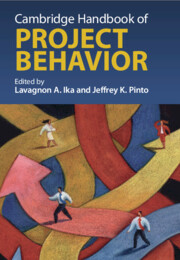Book contents
- Cambridge Handbook of Project Behavior
- Cambridge Handbook of Project Behavior
- Copyright page
- Contents
- Figures
- Tables
- Contributors
- Introduction
- Part I Guiding Principles
- Part II Deviating from Plans
- Chapter 6 Averaging Out Divergent Project Behavior
- Chapter 7 Intra- and Inter-Organizational Governance and the Behavior of Projects
- Chapter 8 Strategic Alignment, Uncertainties, and Realignment of Project Portfolios
- Chapter 9 Stakeholder Perceptions and Project Performance
- Chapter 10 Governance Shifts and Short-term Performance
- Chapter 11 Maximum Feasible Project Failure
- Chapter 12 Project Misbehavior in Infrastructure Projects
- Part III Practical Tips
- Index
- References
Chapter 9 - Stakeholder Perceptions and Project Performance
from Part II - Deviating from Plans
Published online by Cambridge University Press: 22 November 2025
- Cambridge Handbook of Project Behavior
- Cambridge Handbook of Project Behavior
- Copyright page
- Contents
- Figures
- Tables
- Contributors
- Introduction
- Part I Guiding Principles
- Part II Deviating from Plans
- Chapter 6 Averaging Out Divergent Project Behavior
- Chapter 7 Intra- and Inter-Organizational Governance and the Behavior of Projects
- Chapter 8 Strategic Alignment, Uncertainties, and Realignment of Project Portfolios
- Chapter 9 Stakeholder Perceptions and Project Performance
- Chapter 10 Governance Shifts and Short-term Performance
- Chapter 11 Maximum Feasible Project Failure
- Chapter 12 Project Misbehavior in Infrastructure Projects
- Part III Practical Tips
- Index
- References
Summary
The chapter highlights the importance of stakeholders as a crucial aspect in understanding project behaviour. Effective stakeholder identification and management allows project managers to understand the needs and motivations of all individuals and groups who can impact or be impacted by a project. This information is crucial in ensuring project success by helping project managers to effectively manage stakeholder expectations and build strong relationships.
The aim of this chapter is to enable the project manager to better consider and plan stakeholder management throughout the life of the project to maximise decision-making and benefits. It will elaborate on the challenges when including different stakeholder perceptions for project performance. The assumption is that it is essential to control the project’s outcome parameters through stakeholder expectations to minimise the chances of failure and maximise performance.
Engaging stakeholders in any project environment, local regional, national or global all brings separate complexities. To deliver outcomes successfully, project managers need to develop a much clearer understanding of stakeholder perceptions, expectations and priorities to enable them to cope with any changes or uncertainty as the project evolves throughout the lifecycle.
Keywords
Information
- Type
- Chapter
- Information
- Cambridge Handbook of Project Behavior , pp. 144 - 157Publisher: Cambridge University PressPrint publication year: 2025
References
Accessibility standard: WCAG 2.0 A
Why this information is here
This section outlines the accessibility features of this content - including support for screen readers, full keyboard navigation and high-contrast display options. This may not be relevant for you.Accessibility Information
Content Navigation
Allows you to navigate directly to chapters, sections, or non‐text items through a linked table of contents, reducing the need for extensive scrolling.
Provides an interactive index, letting you go straight to where a term or subject appears in the text without manual searching.
Reading Order & Textual Equivalents
You will encounter all content (including footnotes, captions, etc.) in a clear, sequential flow, making it easier to follow with assistive tools like screen readers.
You get concise descriptions (for images, charts, or media clips), ensuring you do not miss crucial information when visual or audio elements are not accessible.
You get more than just short alt text: you have comprehensive text equivalents, transcripts, captions, or audio descriptions for substantial non‐text content, which is especially helpful for complex visuals or multimedia.
You can access graphs or charts in a text or tabular format, so you are not excluded if you cannot process visual displays.
Visual Accessibility
You will still understand key ideas or prompts without relying solely on colour, which is especially helpful if you have colour vision deficiencies.
You benefit from high‐contrast text, which improves legibility if you have low vision or if you are reading in less‐than‐ideal lighting conditions.
